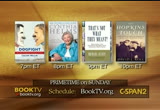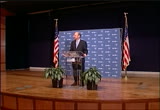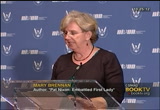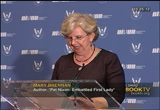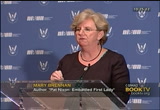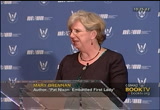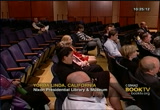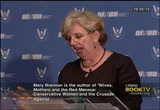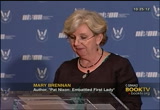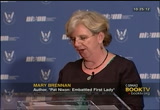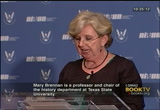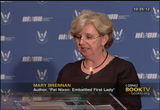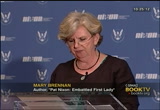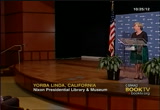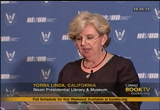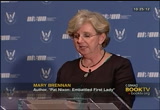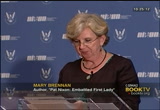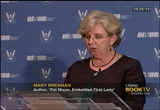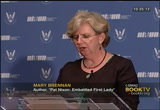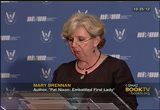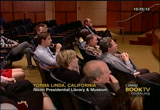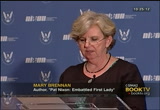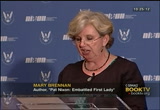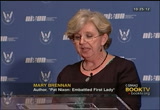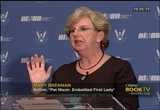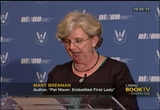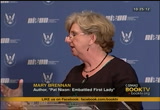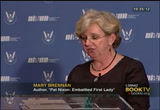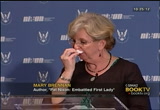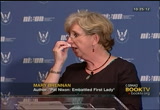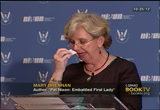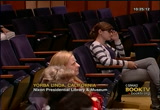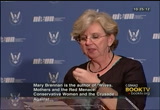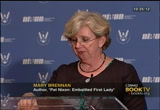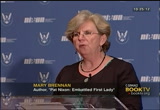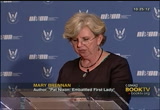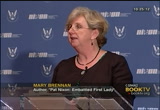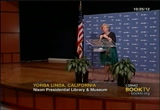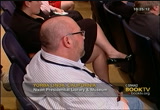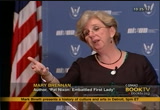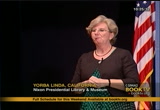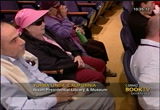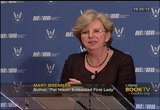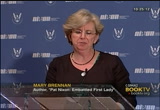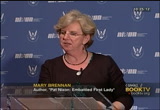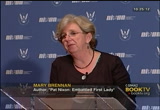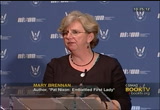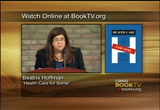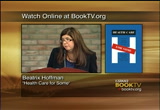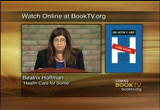tv Book TV CSPAN January 13, 2013 4:00pm-5:00pm EST
4:00 pm
4:01 pm
mary brennan discusses the use of mrs. nixon's recently-released private documents. this is just over 50 minutes. >> um, welcome to the richard nixon presidential library and museum. my name is paul wormser, and i'm the acting director of the librariment i appreciate all of you coming to one of our continuing author talk presentations. today we are very fortunate to have really the leading scholar on pat nixon who is, by the way, born 100 year ago this year. mary brennan, who did much of her research here for her book, is the chair of the department of history at the yawfort of texas in -- university of texas in san marcos. the -- excuse me.
4:02 pm
her specialty is post-world war ii conservative movements, and she has written b to date three different books, those being "turning right at the '60s: the conservative capture of the gop," "wives, mothers and the red menace," and, of course, the book that we love most around here, which is "pat nixon: embattled first lady." her book is an outstanding work, and i look forward to -- or or i would like you to help me welcome her out onto the stage to talk about her work. mary brennan. [applause] >> thank you, paul. it is such a great honor to be back here at the nixon library. as paul said, i did much of my research here, and i feel very close to all of the people here. they were so helpful to me in learning what i did about pat.
4:03 pm
i'd like to begin with a story. one even anything 1954 -- evening in 1954 as the nixons exited a dinner, they came across an indian woman sitting on a bench outside the banquet hall. pat taught she recognized the woman. they continued down the stairs. halfway down, pat remembered the woman and made her husband return to where the woman was sitting. pat spoke with the woman and asked her if they had not met previously. when the woman replied that they had, pat asked about her stay in the u.s. and inquired what she was doing in a hallway. the woman explained that she was returning to india in a few days and hoped to catch a glimpse of the president before she went home. pat then arranged for the woman to be given a seat at the dinner so that she could hear the speech as well as see the president. nixon then left the hall to continue on to their continuous
4:04 pm
engagement. i use this story to begin my talk because i think it exemplifies several key points i wish to make about pat nixon in her public role, more particularly about her role as foreign diplomat. first, pat met the indian woman during one of her travels as second lady. for pat the traveling she did as first and second lady was the best part of her job as a political wife. second, this woman was not the wife of an ambassador or statesman, she was just a young woman who had come to the united states who had come out first to see the second lady and then had come to the united states to study. pat didn't limit her contact on her travels to important people. she treated everyone she met as though they were the most important person in the world. the people she met sensed her sincerity and responded to it. third, she was happiest in her role when she could take action.
4:05 pm
the party the nixons were at and the engagement they were going to were not as important at that moment as getting this visitor from india a seat at the presidential dinner. in the greater scheme of things, this is really a small act. but it left a lasting impression both on the woman involved, the indian woman involved, and on the women at the table that she was eventually seated at. that's how we actually know about the event, is through a letter that someone who she ended up sitting with responded and wrote to pat later about it. for pat politics was her job and one she didn't always enjoy. while on occasion she was proud of her work in helping to raise funds for the party, she found many of huertasings frustrate -- huertasings frustrating and mind numbing. by the end of the first term, she expressed her jealousy of her friends' reentry into the work force. the thrill of meeting famous men and women and the glamour of
4:06 pm
white tie dinners at the white house wore off leaving only the tiring routine of constant evenings away from her girls and idle chatter with women she did not always like. for someone who had worked hard her entire life -- and she had worked hard her entire life -- the situation could at times be intolerable. it was not the long hours or the physical challenges that weighed her down. she resented not being useful, not doing something meaningful. perhaps that is why foreign travel appealed to her. during her trips overseas, she felt that she was playing an important role. she was representing american interests abroad. her introduction toking representative america came during her first year as second lady when president eisenhower sent his vice president on a tour beginning in asia and continuing to parts of the subcontinue innocent during the fall of -- continue innocent during the fall of 1953. president eisenhower told the
4:07 pm
vice president that he should take pat with him and that he realized this trip was going to be work, but it was going to be interesting. pat described the impending trip in those exact same words in a letter she wrote to a good friend next month. along with a minimal entourage that included a military aide, a state department representative, a flight surgeon, three press representatives, two secret service agents, nixon's administrative assistant and the only other woman on the trip, rosemary woods, the nixons embarked on their 42,000-mile journey. in a little more than two months, the group visited over 15 countries, attended hundreds of state dinners, participated in innumerable ceremonies and spoke with millions of people. the state department had briefed the group on the many countries and peoples they would be visiting. pat took these briefings very much to heart. in fact, one member of the group told a reporter a few years later that pat had served as the
4:08 pm
group's walking encyclopedia. whenever they needed information about whatever country they were in or the culture, they would always turn to her, because she would have the information. her husband concentrated on the larger mission of reassuring america's asian allies and friends clarifying eisenhower's policies and assessing attitudes toward communism. while he did that, pat's role was to go out and meet the people. neither he nor pat had ever been particularly interested in formal socializing, so he requested that official dinners be kept to a minimum so that they could meet with as many different people as possible in the countries they visited. pat recognized that there was a job to be done as she wrote in her travel diary. she could not help be caught up in the thrill of traveling. lean her sadness at leave -- even her sadness at leaving the girls did not overwhelm her excitement. the harsh reality of such extensive travel combined with a little girl's enthusiasm for
4:09 pm
seeing new and different sights leaps off the pages of her diary. she gleefully recorded her initiation ceremony as she crossed the equator for the first time. quote: dick acted as neptune and wore the crown as design by the crew. what fun. attendance at a female frolic where the hostess arranged all-male entertainment. she detailed their experience in a village in new zealand where dick had to take part in an actual dialogue. both she and dick then had to participate in the custom of nose rubbing. although she said that she felt faint when some of the disheveled oldsters lined up for a session of nose rubbing, the nixons wanted to be good sport, so they took it. she actually had more problems because she also visited the kitchen where the women were cooking the food that they were going to be eating later on, and she said that the kitchen was so dirty and unsanitary that she
4:10 pm
was actually really quite leery of eating the food that was given to them, and she kind of had learned the art of pushing food around on her plate and covering things up so it looked like she was eating without actually having to eat anything. this would prove to be the case on all the overseas case the nixons would make during the vice presidential years. although their schedules were often crowded with official duties and the conditions could be challenging, pat continued to be thrilled at visiting new countries. in early 1956 she and dick attended the inauguration of the new brazilian president in rio de janeiro, a city that she called the most spectacularly beautiful city she had ever seen and where the parties at the palace were fabulous. but they actually went in january, so there was something like a 75-degree climate change when they went in one day. in july of that year, the nixons set off on another whirlwind
4:11 pm
tour. she explained in a letter that this was a fast and furious -- fast and full trip. in the course of one day, they were in three countries; thailand, pakistan and turkey. although her husband met with government leaders, she again had her own schedule of events. in the end, she wrote, it left us dizzy but happy that in such a short time so much could be accomplished. in november of 1958, the couple traveled to london where pat wowed much of the british press with her natty wardrobe and unspoiled manner. the following year they went to the soviet union and poland. in moscow, dick confronted nikita khrushchev in an exhibition of american consumer goods. pat once again had her own agenda of visiting orphanages and hospitals. he might have gotten more headlines, but pat's interaction with soviet women and children also made a lasting impression.
4:12 pm
she actually, there were all kinds of pictures offer happening out candy and bubble gum to the soviet children that made it into "life" magazine. perhaps more importantly, her pointed questions to nikita khrushchev about his wife's absence from the festivities led to mrs. khrushchev as well as the wives of other soviet officials suddenly appearing at the events during the rest of the visit. she told one reporter that she thought it helped to have a woman along on a dip romatic mission. they can -- diplomatic mission. she was overwhelmed by the outpouring of cheers that greeted the nixons as they traveled through the streets of poland. pat, who was not easily rattled, had to fight back tears according to one news account of their arrival in poland. when pat became first lady almost ten years later, her recognition of the important role travel allowed her to play only increased. the giddy, wonder-struck
4:13 pm
traveler remains, but she had become much more aware of the potential power of her position. during her five years as first lady, pat visited 32 countries around the world, several more than once. she accompanied her husband on his ground-breaking trip to china and set new precedents herself by traveling solo as an official representative of the united states to the inauguration of president william toll bare of high beer ya in 1972 and repeating the task in 1974 by attending the swearing-in ceremony of err nesto gazelle. she trove, quote -- strove, quote, to make as many friends as possible, end quote, for herself and the country. while her desire to make friends everywhere might have had political consequences, it arose from a sincere desire to look beyond the dignitaries to the people of the countries she visited. in part because of the connection with her own roots. she never forgot who she was or
4:14 pm
where she came from. she was the daughter of a truck farmer who had supported herself since she was a teenager. at one point during her husband's administration, she told a childhood friend that even though she occasionally felt inadequate to the task that, quote, she was only pat ryan from artesia, end quote, the people she met were so gracious that she felt comfortable continuing the important work she and her husband were doing. in addition, since she came from a small town, she understood what a thrill it was for someone to shake the hand of the second or first lady of the united states or to receive a letter from the white house. as a result, from her first trips as second lady through her white house years, she attended the official visits with her husband that she was supposed to, but she also insisted on having her own separate itinerary that went beyond just the government-sponsored or approved women's teas and socials. she made it a point to seek out
4:15 pm
the institutions that affected women and children. ever the business teacher, pat jotted her reactions to the sights and people she met in shorthand on her official schedule. in salon during her or vice presidential trip, she, quote, went with mrs. silva to see a hospital and a home for the aged. she commented that the old people were thrilled because nobody had been to see them. in the philippines she visited an orphanage and a training center for learning trades which can be done in the homes. in south korea she went to a republic of korea division hospital and gave out candy and cigarettes. her brief comments indicated the state of things. quote, in heat, wounded on army cots with army blankets, soiled bed clothes, end quote. when her first tour as second lady ended, she visited over 200 institutions that were promoting industry, training women to support themselves and their children, setting up neighborhood kitchens and
4:16 pm
dispensaries. because her group made unscheduled stops, she felt that they were able to, quote, get the real picture. she concluded that in general people canceps when another -- can sense when another person is friendly and genuinely interested. that is what they tried to do, to show them, to show the people they were visiting that they were interested in them as people. someone once asked pat why she could appear to be so interested in all these diverse peoples that she met, and she said that's because i am. she said i look at the person i'm talking to, and i know they have a story to tell, and i want the hear that story. so all i'm doing is paying attention to them while i'm talking to them. pat took her role as representative of united states very seriously. she saw herself as part of an important official team. she certainly made something of an impression on the people she met. one constituent explained to pat
4:17 pm
that her husband was on an around-the-world business trip and had run into what he called the pat nixon trail. he wrote his wife that pat, quote, really rang a bell in this part of the world at a time when americans were not very popular. an american couple living in india sent pat a similar letter after her return, praising the couple for bringing, quote, a fresh understanding of america, end quote, to the people of india. president eisenhower praised both nixons for their work on the trip. even the american press noticed pat's role on the tour. the new york journal american explained that although she did not make any speeches or or carry on high policy discussions, she bore her full share of the workload. her love of travel, her opennesses to new peoples and places, her quick smile and genuinely kind heart endeared her to the people she met and made her a wonderful unofficial ambassador for the united states. in fact, in 1957 journalist earl
4:18 pm
mazo labeled her this country's most effective female ambassador of goodwill after accompanying pat and dick on a tour through africa and italy and watching as she, quote, charmed peasants by the thousands and potentates by the dozens, end quote. without talking politics, pat managed to win over not only the, quote, ragged women in a monorove yang salt market, but also sultan mohamed sank who granted her an unprecedented formal audience. her goal, she told mazo, was to convince people we enjoy being here and are genuinely interested in them. mazoing was not the only one to see the importance in her role. by the time of the soviet trip, the last of the vice presidential ones, pat as ambassador of goodwill had won over even "the new york times" calling her a diplomat in high heels, the reporter described her as self-possessed, self-made, orderly and precise.
4:19 pm
the capital press club, an organization of african-american news correspondents, presented her with its international relations award in 1957 recognizing, quote, her goodwill activities among the people of eight african countries, end quote. they choser her as america's outstanding ambassador of goodwill. deputy attorney general william rogers wrote to pat following a trip through europe during which he had been bombarded with requests for her presence on the next vice presidential trip. he praised her important and significant role in public affairs. of all of her responsibilities as second lady, the travel not only fulfilled her childhood dreams, but had also allowed her to feel a useful and necessary part of an important enterprise. when her husband had first run for office, the nixons had been a team, and pat had been a crucial player. as his career took off in different directions, pat sometimes felt relegated to the
4:20 pm
sidelines. her work overseas reinforced that she was still significant not just to her husband's career, but to something larger. when she became first lady, foreign travel -- whether with her husband or on her own -- continued to play this vital role for pat, allowing her to participate in the political realm in a positive way at a time when many other pasts were limited. pat spent much of her time in the white house working against political aides who did not value her advice, opinions or presence. many of these men treated her as a prop to be used for publicity purposes only. her domestic agenda, her first lady cause, did not ignite passion in the public. plus she faced challenges from a shifting social order as the women's movement spread throughout the country. pat, the supermom and superwife, faced ridicule from a feminist press for letting her husband push her into politics. the more conservative press praised her willingnesses to
4:21 pm
stand by her husband. pat the woman hated the increased lack of privacy and longed for something meaningful to do. traveling abroad took her away from the frustrations at home and allowed her to be herself. even her husband, who excluded her from most important policy decisions, did recognize her as an asset when it came to foreign policy. years later he told former aide frank gannon during a series of interviews that pat always handled herself very properly, even during seasonstive diplomatic -- sensitive diplomatic conversations that she might overhear. he explained that she, quote, listened and nodded but never made comments of her own. at the same time, however, he relied on her to notice things he did not because, as he put it, she was very observant. giving pat some responsibility and small diplomatic tasks also provided nix sob with cover from the increasingly voc feminists who demanded more of a role. she was a woman he could trust
4:22 pm
to do only what he expected her to do. pat's foreign traveling did more than feed her desire for the adventure of visiting new places, it was a way of reconnecting to the dick and pat team of old. she had never been more a part of his life and work than when they traveled together during the vice presidential years. certainly, the circumstances had changed. now they traveled with a huge entourage of aides, security personnel and reporters and feelings toward the u.s. had hard ped over the years. but her husband's faith in her abilities demonstrated by his willingnesses to send her off by herself must have gratified her. she seized the opportunities to prove herself. pat's trip to peru in 1970 epitomized her value as a foreign ambassador. on may 31, 1970, an earthquake measuring 7.75 on the richter scale devastated about half of peru killing at least 50,000 people and displacing hundreds of thousands of others.
4:23 pm
mudslides followed the initial quake causing further damage. homeless, injured and starving, survivors rushed to the coastal areas in search of medical anticipation and news of loved ones. as news reports filtered back to the united states, president nixon promised $10 million in aid as well as promising to loan army and navy helicopters for the search and rescue mission. the american public, moved by the devastation, had begun donating supplies and money to be sent to the people of peru. similarly empathetic, pat wanted to help. during a weekend at camp david, the couple discussed the situation, and dick raised the possibility of pat personally delivering their donations from the american people. a week later she flew to peru and met the wife of the peruvian president in lima to deliver donation, visit the injured and homeless and review the damage. she took with her over 18,000 pounds of clothing, blankets and
4:24 pm
other goods as well as cash donations. during her brief stay, she accompanied a tour of the most devastated region. sitting only on a repurposed kitchen chair with no seat belt, walking amid the rubble she hugged children and offered comfort to those who had lost everything. her genuine concern and sympathy did much to ease the tension that had existed between the u.s. and peru. an editorial in the main newspaper in lima noted that, quote, the profound significance of pat's visit. in her human warmth and identification with the suffering of the peruvian people, the editorial continued, she had gone beyond the norms of international courtesy. the people of peru appreciated the understanding and concern that she demonstrated in our sorrow. on her departure v.a.less coe awarded her the grand cross of
4:25 pm
the order of the sun. even "the washington post," which rarely had much positive to say about the nixon administration, admitted that she had, quote, threaded her way among all the potential sources of trouble admirably and with skill. epitomizing the simple human response required by the tragedy, the editorialist continued, she succeeded in communicating to the peruvians she met a genuine desire to help and to have done so with great task for all of which she deserves much credit. if the trip to peru showed the potential for pat to serve as a goodwill ambassador, her trip the following year to africa displayed her determination to break through the restraints of her first lady role. in early january 1972, pat set out on an eight-day, 10,000-mile trip to the african continent where she visited liberia, ghana and the ivory coast. the primary mission of the trip was to participate in the inauguration of william holder,
4:26 pm
the new president of liberia. for the first time, the first lady would be the official representative of the united states. as such, pat met privately with the president as well as prime e prime minister and the president of ghana and the president -- sorry, of the ivory coast. i think i just murdered their names, for which i apologize. her official party of 40 included the reverend billy graham. he and tolbert were both ministers, and mrs. john h. johnson, the wife of the president of johnson publishing company. in addition to official meetings, press conferences and speeches before political parties, the africans treated pat and her entourage to a whirlwind of dippers, receptions -- dippers, receptions and presentations.
4:27 pm
pat took her responsibilities on the trip very seriously. duly noted in the biography that pat snuck away on christmas day to go over her briefing notes to organize her thoughts for the upcoming trip. although the state department and the staff of the west wing prepared remarks for her, she went over them making changes where she felt necessary. if liberia, she pleased her hosts by noting how impressed she was by the considerable development that had occurred since her last visit in 1957. in ghana she traveled out into the hills to pay her respects to 83-year-old chief -- [inaudible] whom she had met during a vice presidential visit. he told her that she had forged a friendship between the american and ghanaian people that, quote, not even a lion could break. end quote. before she left ghana, she spoke before the national assembly delivering a rare public political speech.
4:28 pm
in each of the three countries, pat spoke with the leaders about her husband's upcoming trip to china explaining that he did not intend to normalize relations, but to open a dialogue. she also reiterated america's promise of financial assistance through aid and development and announced the creation of two graduate scholarships for women to travel to the united states to study. not her official pronouncement, however, that earned her the accolades either in the countries she visited or back home. it was her warmth, her enthusiasm, her genuine appreciation of and affection for the people she met. in monrovia, liberia, she gushed to reporters she could not wait to get around and meet some people. she certainly did that. she waded into crowds shaking hands, giving hugs and patting backs. at the inauguration ceremony, she gave president tolbert a warm cheek-to-cheek embrace. he called her, quote, a woman of courage, strength of character
4:29 pm
and fortitude of spirit, end quote. when a group of women presented her with tradition albright blue cloth, rather than slipping it under her chair, she stood up and began to try to tie it around her waist. the women were shocked to realize what she was trying to do and immediately got up and came up to help her and dressed her in the traditional clothing. pat's delight in the outfit and her willingnesses to model it in front of her audience and the cameras spoke volumes about her respect for the culture and the people she was visiting. and if you had a chance to visit the centennial exhibit, you'll see there's that wonderful picture of pat in the blue head address where you can get your picture taken. that, i think s the most beautiful picture of pat you can find, and it says it speaks volumes about how she felt about her ability to go out and meet these people and to play a role and to show them the respect. and you can just see in her eyes
4:30 pm
in that picture that it was, this was very much something -- it wasn't something she was putting on. it was something that she,. >> she believed in very deeply. all of the news photos show pat with a huge grin on her face whether she is watching a traditional tribal dance, listening to a speech or travel anything a motorcade or actually participating in a tribal dance which she's doing in another photo. pat returned home trium faultily, heralded by the press. time magazine declared her african queen for a week, and "the new york times" marveled that they loved her in monrovia, they love her in alaska rah too. she made one more solo trip as first lady. in 974 she attended the inauguration of the president of brazil and made a stop in caracas, venezuela. by this point her credentials had been well established. however, caught up in the midst of the watergate scandal, the media paid little attention to
4:31 pm
the first lady's travel itinerary which was quite the shame because if you remember, caracas, venezuela, is where the nixons had had that terrible experience during the vice presidential years, and this was one of the first trips back there. and even though the venezuelan press noted this, the american press really did not, really did not relate the significance offer trip to caracas. most of the attention was on her husband's political problems back home. now, 1972 was in many ways a highlight year for pat. in january she goes to africa and has this wonderful experience. she comes back from africa, and in february they prepare for the groundbreaking trip to peking, and then in june they're going to go to moscow. excuse me. pat proved she did not have to be flying solo to make a difference during an official trip. while dick met with leaders and negotiated wording on communiques, negotiated wording
4:32 pm
on communiques, pat toured the countries, met with whatever citizens she was allowed to and attended cultural events. meetings opened communications between countries while pat's efforts helped to forge good feelings among countries involved in international relations. excuse me. dick nixon, a determined anticommunist in the 1940s and '50s, had been working on thawing the world war between the people's republic of china and the u.s. for years. once he became president, he and his national security adviser, henry kissinger, explored different avenues of communication with china. by mid 1971 their efforts had paid off, and china extended an invitation to the president to visit peking. not only would nixon be the first u.s. president to visit the people's republic of china, but because of china's
4:33 pm
self-imposed isolation, one of a limited group of westerners who had ever be been there. as a result, there was tremendous worldwide interest in the trip. when china decided to allow the american press to tag along with the president and mrs. nixon, people around the world followed the february 1972 journey with tremendous interest. dick had to remain sequestered with the chinese leaders much of the time. pat was the representative who introduced americans to china, represented the american people to the chinese. if she had not already realized what a great responsibility she had on her shoulders, the briefing papers she got from the state department made it explicitly clear. emphasizing her role and the unique opportunity the trip represented to reestablish communication between the women of china and america, the state
4:34 pm
department reminded her that she would be the first leading american woman the chinese had met. the intensive u.s. television coverage provided her with the unprecedented opportunity to influence the way in which americans viewed the chinese, chinese women and the social order. pat responded to the pressure by intensifying the normal homeworker routine b she followed before any trip. studying her state department briefing papers carefully, reading quotations from mao, learning useful chinese, phrases of chinese and worrying about her schedule. on most of the trips she had taken both during the 1950s and so far or as first lady, pat had insisted on attending more than the usual ladies' teas and receptions. she asked to visit hospitals, schools and other facilities that helped women or the poor. this time, however, she had very little control over what she could do, where she could go or whom she could meet.
4:35 pm
she need not have worried. although she had the feeling that she was being isolated from the public, she won over the people she did meet. and dealt diplomatically with those who tried to convert her. correspondent helen thomas recounted that when pat's guide invariably young women from the revolutionary committee would try to engage her in a political discussion, she would smile and say, oh, yes, i'm acquainted with his philosophy. from the cooks in the kitchen of the peking hotel -- thank you -- to the vice chairman of the people's commune to -- [inaudible] the chinese melted under pat's warm smile and genuine enthusiasm for experiencing new cultures. during her visit to the kitchen with 115 cooks, she gladly sampled their creations including a fiery stuffed pickled squash. actually, all the reporters were quite impressed, because some of them tried it, and they couldn't
4:36 pm
eat it. but she did. sitting next to the premier in the state dinner, pat commented on the cute pandas drawn on the cigarette holder. nixon also realized that talking to the prc, talking to the chinese leaders would worry the soviets, so when they came back to the visit to china, he had arranged that they would also go back to is owe yet union. -- soviet union. as a result, in 1972 pat, dick and entourage traveled to moscow where dick met with soviet leaders while pat followed her usual separate schedule. accompanied at various times by the soviet leaders who had learned their lesson and brought their wives out when pat was going to be there. pat watched a rehearsal at the ballet school, visited with school children and toured a
4:37 pm
department store. she also attend a russian circus where a performing bear startled her, a sight so much out of the ordinary that the press reported on it in the american papers. as had become her pattern, pat won over the russian people and the reporters who accompanied her. the russians as well as the poles during the couple's visit there appreciated the first lady's delight with the ballet and the circus, her obvious affection for the school children she met and hugged, her easy man we are the wives of the soviet leaders. in fact, at one point mrs. nixon grabbed the happened of mrs. brezhnev who was unused to the throng of reporters and crowds constantly surrounding the women and rather frightened. pat's determination to stop and talk with the people who had come out to meet or see her also we wered her the affection of the population. one incident exemplified her appeal to the ordinary people she encountered on her trip.
4:38 pm
during the trip to warsaw, pat attended a recital. she walked toward the crowd intended to shake hands. her interpreter attempted to lead her back to the official party. she refused to join the group until she had waded into the crowd of men and women who responded very warmly with some men taking off their caps and others kissing her hand. for their part reporters, even the sometimes-critical u.s. correspondents, were extremely complimentary. the globe described her as a remarkable sale woman. the london daily male claimed she was the best boost for womanhood since they invented lipstick, and another reporter had a warm feeling at the sight of mrs. nixon and mrs. brezhnev holding hands. patterned the respect and yacht tuesday some -- gratitude of some of the reporters. reporters had been forced to battle the soviet police who were guarding mrs. nixon. the situation came to a head on the third day of the visit as pat walked through the store,
4:39 pm
hundreds of people crammed onto ball con neys or stood in adjacent aisles to wave and catch a glimpse of her. reporters trying to cover the event found their views blocked by the soviet security detail. pushing became shoveing became fists flying through the air. pat saved one reporter from being man handled by the soviet officer by pulling the reporter to her and offering him a lick of her ice cream cone. her or obvious distress at the situation and her attempt to remedy it did much to win the open admiration of the reporters. and so we end with another story. that reinforces pat's love of travel, her opennesses to all of the people she met including reporters and her willingnesses to take whatever action was necessary. from her youngest days when she listened to her father's stories of his adventures through her years as a single woman taking off on small excursions through the early years of her marriage to dick as they shared their love of visiting new places. travel intrigued pat,
4:40 pm
invigorated her and provided her with opportunities she might not have had otherwise. travel also provided pat with the means to transform the first lady's role. although observers at the time often criticized her for failing to focus on a specific cause the waylaidtybird johnson had or for appearing to mirror too closely mamie eisenhower, pat succeeded in pushing the limits of behaviors, especially in terms of foreign diplomacy. she traveled more than any other first lady up to her time and accompanied her husband on his groundbreaking trip to the people's republic of china. press reports of her interactions with the chinese as she toured the country offered americans a glimpse into the formerly-closed society. building on her experiences as second lady, pat refused to limit her official first lady itineraries to acceptable l ladies' formal teas and receptions. she wanted to visit hospitals and schools. her determination to meet with
4:41 pm
wounded american soldiers during a visit to south vietnam meant she became the first first lady to travel to a combat zone. pat showed that the first lady was not just a ceremonial prop. pat also traveled successfully on her own. her journey to peru following the % quake brought humanitarian relief to the wounded and needy citizens of lima and helped to forge a new relationship between the two countries. when she attended the inauguration of the new president of liberia, she became the first wife of a sitting president to serve as an official representative to a foreign country. pat's enthusiastic response to the people she met in south america and africa served a diplomatic purpose for her husband and secured his opening -- an opening for future first ladies to explore. of in fact, pat's initial success with handling diplomacy on her own led her to take additional solo trips during her husband's term in office. like almost everything else connected to richard nixon, however, pat's expansion of the
4:42 pm
role of first lady was lost in the midst of watergate. rather than celebrating her accomplishments, pat spent her last months in the white house avoiding reporters and urging her husband to fight on. instead of the press incrier quiring about her -- inquiring about her next trip or commenting about her appear anything in a pants suit in a woman's magazine -- another first -- the focus was on the growing scandal. even pat's obituary concentrated more on watergate than on her activities as first lady. pat never came to love politics or the political life, but as she had her entire life, she made the best of a bad situation. building on her love for travel, her natural abilities, both her innate opennesses and her keen observation skills, pat opened the door for the first lady to become an essential part of her husband's foreign policy team. she finally did find her niche of in politics. thank you very much. [applause]
4:43 pm
i would be happy to answer any questions if you have any questions. nobody has any questions? oh. >> hi, ms. brennan. >> hi. >> with when you were doing your research for the book, did you contact the daughters from for any input or insight that helped you gather any additional information that you didn't already find when you were at the library? >> julie actually helped me to gain access to the rest of her mother's papers and to helene's pape ors. and i corresponds with her by e-mail and asked if she would be willing to do an interview, but she said that she had said everything she wanted to in her book, and unless i had a specific question that, um, she really department want to be interviewed -- she really didn't want to be interviewed. and i could not contact her sister. >> hi, mary. >> hi. >> could you expand a little bit more on the first lady's
4:44 pm
domestic agenda and why you think it didn't spark excitement like her foreign travel did? >> i think she became first lady at a difficult time. she had an agenda. her first cause was volunteerism. although she was also very interested in reading. and the volunteerism was something that was very dear to her, because she did very much believe in people helping other people. but you have to remember that it is 1969. the country's in tremendous turmoil, and so something like volunteerism was not going to be a cause that was going to catch on with the general public. she also did run into some obstacles. it was a very tense situation between the west wing and the east wing, and so she did run into some issues in terms of being able to explore and find herself. she did have other things that she did domestically. although jackie kennedy gets a tremendous amount of credit for redecorating the white house, pat actually did more of that.
4:45 pm
she, she hired a, the protocol officer from the state d., brought him over, and the two of them went around the country making deals with different people, different museums to be able to get correct period pieces in the white house and to e restore the white house. to the point that when jackie kennedy came back for the first time since she had left in 1963, 1964, she commented on how wonderful a job pat had done redecorating. i think it also took her a little while to find her stride, and so i think she was just kind of moving in that direction. amidst all of this kind of, she kind of had the double whammy of this shifting historical circumstances out in the public, and the problems that she had within the administration in terms of being able to define her own path. i think the other reality is that she actually felt most comfortable traveling and meeting people and doing, you know, kind of being able to get
4:46 pm
out amongst the people. >> the 'em battle, that she was embattled, during you mean during watergate or after the president? >> well, i have to be honest with you, and i don't know if the press would appreciate my saying this, but, um, when i wrote, when i wrote the manuscript, "embattled first lady" was actually the chapter that dealt with the problems within the white house. the press, i named the whole book "pat nixon. every woman in the white house," which i thought that's what she represented. but they liked the embattled first lady name better, and so the press wins. so that is really kind of how that happened. >> ms. brennan, will you kindly speak to pat ryan before she was
4:47 pm
mrs. nixon? >> many -- certainly. you want me to tell about her childhood? >> yes. and i was also, i would also like you to respond, was she a teacher? >> yes. she, um, actually, she had a very -- when i said at the end that as she had her whole life, she made the best of a bad situation, her mother died when she was 12, and she had two brothers ander father. she helped to take care of the house and, um, to kind of keep everything in order and then go to school where she got very good grades. ended up through kind of a fluke of circumstances that she and her two brother all graduated from high school at the same time. she got skipped ahead, one of her brothers broke his arm, somebody else had some other problems, so it ended up they were all graduating at the same time. so they graduated from high school right around the time that their father became seriously ill. so they had to each find jobs to help to support the farm.
4:48 pm
eventually deciding that they needed to go ahead and sell the farm, they went on and, and then they were going to decide who was going to college, because all three of them wanted to go to college. they decided that the one brother had a scholarship, he would go to college first, the other two would work. so she helped to work to support the brother, and at one point she -- there was a couple that hired her to drive them across the country, and the idea was she would drive them across the country to new york, visit some of her father's relatives and then come -- and they would buy her a plane ticket back, and that's how they would pay her. but when she got to new york and met the relatives, they ended up offering her -- one of them ended up offering her a job. so she lived in new york by he's for a year. she worked in the hospital there. she had tremendous adventures, if you can kind of take the, read between the lines in her letters to her brothers. she was having a great time. she flirted with a doctor who according to some of her relatives wanted to marry her.
4:49 pm
she, she had adventures -- she was working in a tuberculosis hospital, and during snowstorms they would go out and go sled riding, and somebody said weren't you afraid that you're going to get ill? she said, no, no, i think about the young boys and how this is going to make them feel. eventually, her brother wrote to her and said we've saved up enough money, come back. she came back, she went to college. she was working on a business degree. she really had hoped to be what we would, um, call today like a personal buyer, a personal shopper. but she realized that it was going to take too long for her to work her way up, and she was a very practical woman. so she said, okay, i'll get my degree, i'll get my teaching certificate as well. so she did, she got her teaching certificate and got a job in wittier. it was while she was in whittier teaching at the school there that she had -- that's when she kind of for the first time in her life had enough money and
4:50 pm
enough freedom to be able to take little trips that she wanted to take. she had some girlfriends that she would go and visit and that she wrote to. she would go off on little excursions. but it's also while she's there that one of the older teachers says to her we're doing a commitment play, and it would probably be a -- a community play, and it would probably be a good idea if you're in this play, and that was back in the day when an older teacher told you you should do this, you did it. it wasn't something farfetched, so she joined the theater group. dick nixon was in the theater group, and they met. now, i would also encourage you that if you have not -- the other part of the pat nixon exhibit that you really need to see to be able to see a different side of dick nixon is to read the excerpts from the love letters. we have a tendency to think of him, and i have to tell you one of the most eye-opening experiences of doing my research was reading the love letters between the two of them. there was a, there are just all
4:51 pm
of these letters in which they're very flayful, writing back and forth to one another. and especially him, he was really chasing her. and he would sometimes, he would sometimes, she would need a ride into los angeles, so he would take her into los angeles, and maybe she was going to meet somebody else there, you know? but he would take her, and then they would go on, they would go on long drives, and they would go up the coast, and they would each take a book. and then they would get out of the car and perhaps have a picnic line up. , and then -- lunch, and they would each read their own book. it was a very quiet kind of dating. but eventually it progressed into something else, and they agreed to get married. so it was a very -- it's not necessarily, it's a, it's kind of one of those things that marriages go through, i think, that in the beginning you have this very romantic kind of relationship. even when he's first elected to congress and he writes her letters from his first trip abroad, the letters are filled
4:52 pm
with all of these visions for this is what's going to happen when we come back. they had this wonderful nurse nursery. i checked out the ship, we can take trisha down there, we'll go see the sights of europe. so for years he actually promised to take her to europe. it didn't actually happen as a vacation until 1963. but he was still promising that it was going to happen. so does that answer your question? uh-huh? >> think we have time for just one more question. >> i'd just be curious to know a little bit about her family, born in nevada? what did their father do there? why did they move to california? what were his parents like, her mother's parents like?
4:53 pm
>> okay. now we're getting into a tricky area. so her father was the son of irish immigrants, and he had traveled around as an itinerant -- he had done a lot of different things. he had been on a merchant ship. he would kind of talk to her about his adventures. he had been a miner. her mother was a first generation german immigrant, and her mother had been married before. her mother was, um, her mother came over as a child with an aunt, ended up staying and eventually married a man named bender. they moved up to -- what dakota did we decide it was? i think it was north dakota. moved up to north dakota, and he was killed in a flood up there. now, actually, i tried very hard to find information about the flood that killed him. i called the archives, i called
4:54 pm
the -- i spoke to the around conservativist and really could not find a tremendous amount of information about her mother's first husband. from that marriage she did have two children, all right? and she, then they moved, then she married will ryan, and they moved to nevada. they moved to, actually, several little towns in nevada. and he was a miner. but kate did not like this. she had lost one husband to mining, and she did not want to lose another one. so she was constantly putting pressure on him to give up the mining life to move something, to become something else, to be a farmer, to be something else that would be more stable and less dangerous. and so eventually they moved to southern california where he continues to have dreams of a kind of finding gold, of doing something that would get them, you know, other than being a truck farmer. but it doesn't happen the way he wants it to.
4:55 pm
well, thank you all. >> and let's give mary brennan a hand. [applause] >> tell us what you think about our programming this weekend. you can tweet us us @booktv, comment on our facebook wall or or send us an e-mail. booktv,en in fiction books -- nonfiction books every weekend on c-span2. >> we don't know whether franklin roosevelt ever heard about florence greenberg's unprecedented call for health care as a right, because even though he had endorsed the conference, he chose that time to go on vacation. fdr was actually on a cruise. i guess we can't really blame him, it was probably a pretty well-deserved vacation. but three years earlier fdr had refused to include medical coverage as part of the social security act because he did not want to an tagtize the american
4:56 pm
medical profession. he did send a message of support to the health conference, but not long afterward the outbreak of world war ii forced the president's attention elsewhere. five years later on january 11, 944, in his state of the union address roosevelt spoke to the american people about the war and especially about the kind of peace the allies planned to establish after the defeat of fascism. he said that the one supreme objective for the future can be summed up in one word: security. and that means not only physical security which provides safety from attacks by aggressors, it means also economic security and social security. the individual political rights upon which the united states had been built, roosevelt argued, were necessary but not sufficient to guarantee true freedom and security. fdr then announced an economic
4:57 pm
bill of rights which is sometimes called the second bill of rights that included the right to a job and a living became, the right to housing, education and security in old age and a right to adequate medical care and the opportunity to achieve and enjoy good health. so even though fdr missed hearing florence greenberg's speech, we hear echoes of it in his second bill of rights. the idea of economic and social rights as essential supplements to political rights had started as far back as the french revolution, but the idea of a right to medical care was something much more recent. discussion of this kind of right became prominent in the 1930s and '40s first of all because medical care itself was becoming more effective, it was starting to matter much more in everyone's lives.
4:58 pm
but before the public knew about medical miracles like vaccinations, penicillin, antiseptic surgeon, treatments that could save lives and even extend life. and to withhold these miracles came to seem unjust. in medical care at this time, it was also starting to cost more than ever before. the average family could not afford to pay for a hospital stay or a major illness or the birth of a child just out of their wages. so medical care had become not just a matter of life and health, it was also becoming something that could cause serious financial hardship. that is why medical care became a matter of economic security as well as health security. in the u.s. demands for medical care as a social right originated in the workers' movements represented by people like florence greenberg.
4:59 pm
they next came to national prominence in fdr's proposed second bill of rights and finally, they were adopted in the united nations universal declaration of human rights after world war ii thanks in part to eleanor roosevelt who helped draft the u.n.'s declaration after her husband's death. today more than 70 countries recognize a right to health or health care in their constitutions. virtually every industrialized nation has taken steps to implement these rights by establishing some type of universal health coverage for their citizens. ..
124 Views
IN COLLECTIONS
CSPAN2 Television Archive
Television Archive  Television Archive News Search Service
Television Archive News Search Service 
Uploaded by TV Archive on

 Live Music Archive
Live Music Archive Librivox Free Audio
Librivox Free Audio Metropolitan Museum
Metropolitan Museum Cleveland Museum of Art
Cleveland Museum of Art Internet Arcade
Internet Arcade Console Living Room
Console Living Room Books to Borrow
Books to Borrow Open Library
Open Library TV News
TV News Understanding 9/11
Understanding 9/11
